Gentrification, Poetry and Unconventional Theater in Jeff Becker’s SEA OF COMMON CATASTROPHE
Visual Arts Features Jeff Becker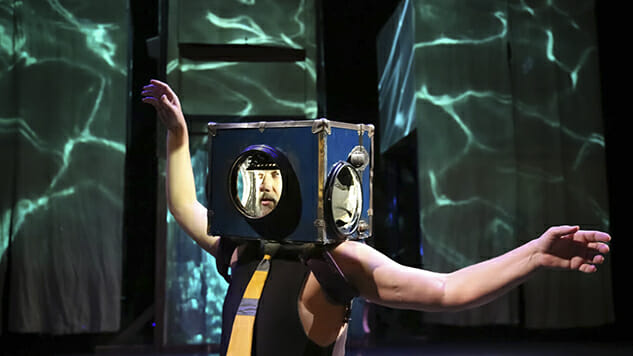
At first they swam along and then they went down very deep to where the light of the sun stopped and then the light of the sea, and things were visible only in their own light. They passed a submerged village with men and women on horseback turning about a musical kiosk. It was a splendid day and there were brightly colored flowers on the terraces. “A Sunday sank at about eleven o’clock in the morning,” Mr. Herbert said. “It must have been some cataclysm.”
It was this passage from Sea of Lost Time, a short story by Gabriel Garcia Marquez, that inspired Jeff Becker to consider what would later become SEA OF COMMON CATASTROPHE. Even though he directed and designed the show, Becker would rather be known as the “instigator” of the project, and credits much of the production to his colleagues. He would also rather you didn’t view SEA as a work of theater, but as a kind of visual poetry blending multiple disciplines. “It is a multilayered experience that is full of symbolism and metaphor without a linear didactic story line,” said Becker, “In this way the performance is more like a poem, painting, dance or a dream that affects you on many levels.”
This isn’t the first time Becker has rejected traditional theater, as he has worked in unconventional sites such as the Louisiana Wetlands for his production Cry Me One. He cites barrier-pushing performances artists such as Ann Hamilton, Marina Abramovic, Nam Jun Paik, Chris Burden and Laurie Anderson as his influences. For this reason, when SEA came to the 7 Stages Theater in Atlanta, we chose review it as a work of art, rather than conventional theater. As the performance went on, it became apparent that SEA was neither visual art or theater—it defies categorization.
When I look through my notes taken during the performance, they look like the scribblings of a drunken madman. Phrases scrawled rapidly like “boxes as theme,” “the gentrifier dances,” “cardboard door collapses on Clara,” and my personal favorite, “selling pint pint row boat comic money” form a kind of entry-level dadaesque poetry. However, for all its randomness and surrealism, SEA has a pretty clear themes. But even before all that begins, the first thing you notice is the unique set design.

SEA takes place on a precarious two-level structure, which serves at various points as a wall of cardboard boxes, a dance floor, a house and a coffee shop. At times, the immense structure serves as a projector screen for Becker’s own illustrations of turtles, fishing boats, seagrass, six-pack plastic rings and more, animated by Courtney Egan. Immediately, the set design feels both very DIY and anti-traditionalist. At 7 Stages, the set is also startlingly close to the audience, and Becker believes the proximity allowed for a better experience. Whether you want to be or not, you are immediately encased in this strange new world. As soon as you are acquainted, however, the themes of displacement and navigation take hold. Unlike New Orleans audiences, who had to physically move through the set, Atlanta audiences are stationary, but it doesn’t feel like it. We are in a rowboat, and the sea is about to get rocky.
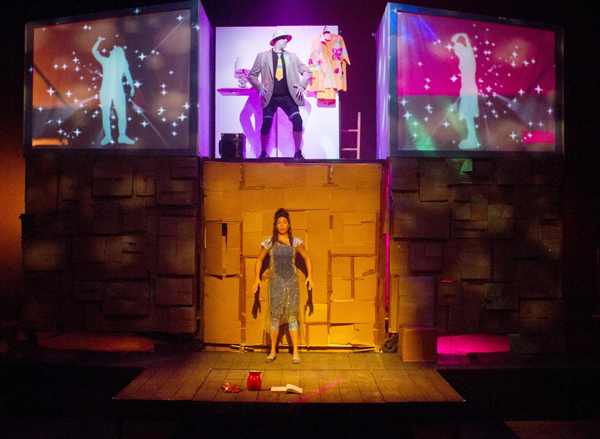
We begin with Clara, played by the great Mahalia Abéo Tibbs, a beautiful woman who appears to have risen from the sea. Someone in the audience said the word “mermaid,” but Clara’s presence felt more spiritual than childish. She recites a verse on “how to make a sea in 10 easy steps,” and so begins the recurring character of Water. Water is everywhere in this production, from the title to the sound to the character’s dress to a metaphor for gentrification—though at times, it is also a symbol of comfort. We follow Clara and her magic red vase that talks to her in her grandmother’s voice, repeating unexpectedly profound phrases like, “There was a time when I could walk on water, but I still know how to fly.” Clara’s world consists of her friend Perpetua and the mischievous Tobias. They all seem to be facing hard times, as they constantly pack and unpack boxes, and Tobias, clad in an oversized, many-pocketed jacket, continously tries to steal things. Their world is interrupted by Mr. Herbert, the gentrifier.
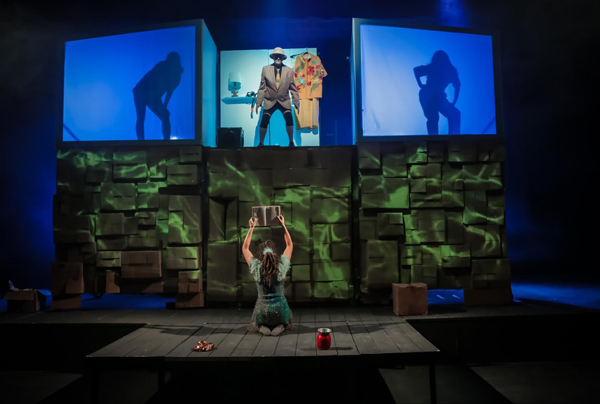
While gentrification in both Atlanta and New Orleans is a devastating reality, Mr. Herbert, played by the talented Jeffrey Gunshol (who also served as choreographer), keeps things light by serving as effective comic relief. He wears a safari-esque hat echoing centuries past of imperialism and a large yellow tie. He is bumbling and goofy, and makes the audience laugh with his over-exaggerated facial expressions, general cluelessness and awkward dance moves. Early in the show, one particular dance scene is a big highlight, as Mr. Herbert, flanked by two shadow figures, “undulates” is a weird moment of ecstasy that feels both preposterous and hilarious. Projections of the words “potential” and “possibilities” float on the second floor set walls, bursting as Mr. Herbert settles in. Perpetua, played by Kathy Randels, sells her house to Mr. Herbert by signing a cartoonishly long scroll. Mr. Herbet implies he will turn her home into a coffee shop. It’s all a bit whimsical and absurdist, and it tries hard to keep from sinking into negativity, even though Clara is clearly uncomfortable with the whole ordeal. It’s funny, but at times it feels a bit painful. While we laugh, real people in the real world become homeless.

There are genuine moments in SEA that feel as poetic as Becker’s inspiration from Garcia Marquez. At one point, the set seems to fall apart as Clara, Perpetua and Tobia perform a kind of ballet atop “floating” boxes. They wobble and grasp onto one another to stay afloat, and work together to painstakingly move the boxes to get out of the fierce current. This is all happening in front of sea-blue projections and to the soundtrack of crashing waves delicately orchestrated by Sean Larocca. It’s a long scene, repetitive and hypnotic, and also worrisome as you watch the three characters struggle. It’s also a beautiful and oddly hopeful as they pull one another onto more secure boxes. Mr. Herbet stands apart, watching. He does not seem unconcerned, but he doesn’t try to help them, either. Later, Clara and Tobia sit together in a small space on the second floor, looking out into the ocean in mutual silence. Are they angry? Grieved? Or perhaps they are simply thoughtful as they consider the changes happening around them. Either way, we are left breathless.
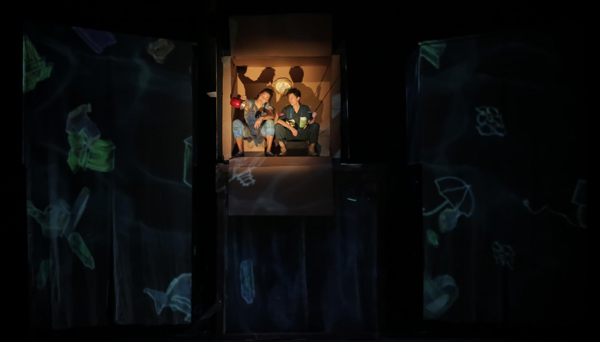
In the post show discussion, Tibbs said the overall message wasn’t negative; rather, it was simply looking at interwoven strands of existence as a whole. Others echoed this sentiment, saying SEA was a conversation about change, and how we can better understand each other. Be that as it may, there was a certain irony to the production, as there is irony with any artistic production focusing on gentrification and expulsion—or, as the production team might call it, “change.”
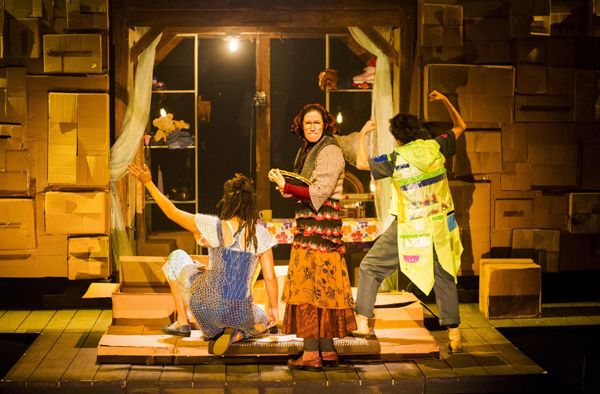
Becker is not unaware of this problem. When the production came to Atlanta, Becker and his team made an effort to hire local actors for certain roles and to offer workshops. While SEA in New Orleans was strongly focused around the after-effects of Hurricane Katrina, in Atlanta they shifted the setting to a more “construction zone” set with orange safety fencing around the perimeters of the stage. In one workshop, participants wrote stories and drew pictures on cardboard boxes of the changes they saw in Atlanta, and how it affected the city and its inhabitants. The boxes were then displayed in the 7 Stages lobby for the audience to enjoy before the show.
It would be a mistake to say SEA is just about gentrification. It is about ritual, community, ancestry and the way we perceive one another in this weird, wonderful world . However, it was still hard to ignore the fact that many of those in the audience were, in fact, Mr. Herberts. It may not have been its intention, but SEA brought up important questions about gentrification and art—namely, can art exist with displacement? Becker is familiar with the paradox that exists between the art community and those expelled from it. He understands that people are attracted to neighborhoods with artists and creative spaces, and acknowledges that as those people buys homes, rising property taxes and insurance rates rise and force people out. Becker believes artists and those who support the arts have a responsibility: “What is important for artists to understand is their complicity in gentrification and ask themselves whom have they displaced, who lived here before them and how does our presence affect the evolution of a community.” When we watch SEA, are we Clara and her friends, helping one another to stay afloat? Or are we Mr. Herbert, watching from a distance, concerned but immobile?
SEA will head to Charleston in the late fall, and they are also currently looking at opportunities in New York, D.C. and New England. Becker would like to acknowledge the contributions of his team of collaborators that his considers his equals: Jeffrey Gunshol, Kathy Randels, Mahalia Abeo Tibbs, Lisa Morashi Shattuck, Sean LaRocca, Courtney Egan, Evan Spigelman, Laura Sirkin Brown, Adella Gautier, Jo Nazro and Becka Mclaughlin.